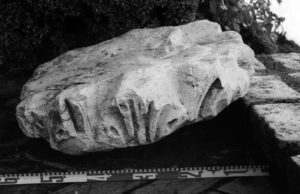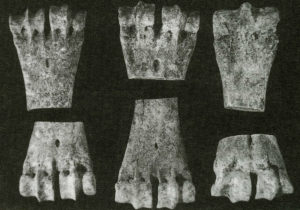
Production and Crafts Activities

The transition from the classical Cordova to the late ancient period also brought with it important alterations in the craftsmanship and productive areas. The gradual abandonment of local stone quarries led to the search for new sources of stone and marble, becoming the former public and semi-public buildings the new (and principal) urban quarries.
Buildings such as the theater, the amphitheater, the forum novum, and the upper terrace of the religious complex of Claudio Marcelo’s street, were converted into sources of raw material towards the end of the third century-beginning of the fourth. From those buildings were removed thousands of cubic meters of stone and marble for several decades or even centuries, as happened with the old theater.

One important novelty in the intramural space was the proliferation of productive activities destined to the extraction of the lime and to the work of the metal, the marble and the bone. Activities traditionally carried out in the port neighborhood bordering the Guadalquivir and, above all, in the space outside the walls.
It is not easy to clarify the evolution of the port district, where ceramic imports (from regions such as North Africa and Gaul) arrived to Cordova at least until the fifth and sixth centuries. Nor is it easy to determine the fate of the high-imperial pottery area located north of the city, although some indirect archaeological evidence reflects the existence of pottery until the fourth and five centuries.

Apart from these activities, there were also developed other agricultural activities that are practically unknown at the moment. Thanks to information from other cities such as Merida, it is very likely that some old domes in Cordova eventually became neighborhood houses whose residents could raise animals and store grain.
Bibliography
BAENA, Mª.D. (2002): “Taller de fabricación de útiles en hueso”, en A. VENTURA et alii (eds.), El teatro romano de Córdoba. Catálogo de la exposición, Córdoba, 279-280.
FUERTES, Mª. C.; HIDALGO, R. (2003): “Cerámicas tardorromanas y altomedievales de Córdoba”, en L. CABALLERO, P. MATEOS y M. RETUERCE (coords.), Cerámicas tardorromanas y altomedievales en la Península Ibérica: ruptura y continuidad. Anejos de Archivo Español de Arqueología, nº 28, Mérida, 505-540.
GARCÍA, B. (2010): “Instalaciones industriales y comerciales en el suburbium occidentale”, en D. VAQUERIZO y J.F. MURILLO (eds.), El anfiteatro romano de Córdoba y su entorno urbano. Análisis arqueológico (ss. I-XIII d.C.). Monografías de Arqueología Cordobesa, nº 19, vol. II, Córdoba, 439-450.
GUTIERREZ, Mª. I. (2004): “Una officina de mármol en Córdoba”, en S.F. RAMALLO (ed.), La decoración arquitectónica en las ciudades romanas de Occidente, Murcia, 563-569.
LEÓN ALONSO, P. et alii (1993): “Informe sucinto de resultados de la excavación arqueológica sistemática en el solar de la Casa Carbonell (Córdoba), 1991. Proyecto: “Análisis arqueológico de la Córdoba romana”, Anuario Arqueológico de Andalucía 1991, vol. II, Sevilla, 158-171.
LEÓN PASTOR, E. (2009-2010): “Portus Cordubensis”, Anejos de Anales de Arqueología Cordobesa, nº 2, 45-72.
MONTERROSO, A. J. (2005): Ex theatro cordubensi. La vida del monumento y la producción de cerámicas africanas en el Valle del Baetis. Monografías de Arqueología Cordobesa, nº 10, Córdoba.
MORENA, J. A.; BOTELLA, D. (1998): “Actuaciones arqueológicas de urgencia en el extremo meridional del casco histórico de Córdoba: el sector de la Ribera”, Anales de Arqueología Cordobesa, nº 9, Córdoba, 131-166.
MORENA, J. A.; LÓPEZ, I. Mª. (1999): “Informe-Memoria de la Intervención Arqueológica de Urgencia efectuada en el nº 3 de la c/ Saravia (Córdoba)”, Anuario Arqueológico de Andalucía 1994, vol. III, Sevilla, 84-95.
MORENO, M.; GUTIÉRREZ, Mª.I. (2008): “El reciclaje marmóreo en Corduba durante el Bajo Imperio (Siglos III-IV d.C.)”, Anejos de Anales de Arqueología Cordobesa, nº 1, Córdoba, 67-82.
PADILLA, A (1999): “Algunos comentarios sobre las canteras de la Bética durante los siglos III-V”, Hispania Antiqua, nº 23, 321-330.
PEÑA, A. (2011): “El reaprovechamiento de material”, en Mª.D. BAENA, C. MÁRQUEZ y D. VAQUERIZO (eds.), Córdoba, reflejo de Roma. Catálogo de la exposición, Córdoba, 108-115.
SÁNCHEZ RAMOS, I. Mª. (2007a): “Decoración arquitectónica y escultura litúrgica en Corduba”, Hortus Artium Medievalium, nº 13, vol. 2, 423-440.
SÁNCHEZ VELASCO, J. (2000): “Evidencias arqueológicas de un taller de mosaicos en Córdoba”, Empúries, nº 52, 289-308.
TORRERAS, S. (2009): “Un vertedero de material arquitectónico romano en el antiguo Cuartel de S. Rafael (Córdoba)”, Anales de Arqueología Cordobesa, nº 20, Córdoba, 461-482.
VARGAS, S. et alii (2007a): “Los contextos cerámicos tardoantiguos de un solar anexo a la Puerta del Puente (Córdoba)”, en M. BONIFAY y J.C. TRÉGLIA (eds.), LRCW 2. Late Roman Coarse Wares, Cooking Wares and amphorae in the Mediterranean: Archaeology and Archeometry. BAR International Series 1662 (I), Oxford, 165-176.
VARGAS, S. et alii (2007b): “Los conjuntos cerámicos tardoantiguos de un edificio cristiano en el sector occidental de Corduba”, en M. BONIFAY y J.C. TRÉGLIA (eds.), LRCW 2. Late Roman Coarse Wares, Cooking Wares and amphorae in the Mediterranean: Archaeology and Archeometry. BAR International Series 1662 (I), Oxford, 177-187.

